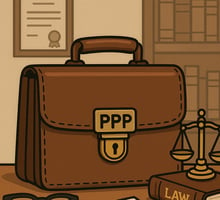A few months back I gave some tips on preparing for depositions. I did not, however, go on to talk...
Depositions - Crystals and Mud
In my last post, I asserted that “The sole purpose of taking a deposition is to get impeachment material for cross-examination.” Does that mean that every question you ask in a deposition must be intended to elicit a cross-worthy answer? Not at all. It’s actually the opposite. To cite a fabricated statistic—that I’m nevertheless confident is mostly correct—97% of the testimony taken in depositions never sees the light of cross-examination.
What is that 97%? It is the supporting infrastructure you need to get the 3% of cross-worthy material. It could be the questions you ask to move the witness towards the admission you want. Or the questions you use to get a sense of the witness’s breadth of knowledge. Or it could be the questions you use to try to get certain admissions that don’t pan out (it happens!).
How do you ask those “supporting” questions? I don’t have a prescription. This is, in some sense, the art of deposition taking. Over the years, I’ve seen very different approaches that are all very effective, at least, in the right hands. I’ve seen attorneys who can get exactly what they want by reading precise, perfectly formulated questions directly from their outline. I’ve seen attorneys whose questioning style is so intimidating that witnesses are almost afraid to disagree. I’ve seen attorneys who can disarm witnesses with charm and good humor. There are a lot of approaches, and, ultimately, you are going to have to find what works best for you through years of practice.
But. I want to share with you the approach that I use and that has served me very well. It may work for you, and even if it doesn’t, I think there are things you’ll learn from it that may help you develop and refine your own style.
The approach I use is what I call the “Crystals and Mud” approach. (And just to prove to you that I was paying at least a little bit of attention in law school, that metaphor comes from an important, though entirely unrelated, paper by Professor Carol Rose on property law.)
The Crystals and Mud approach begins with the following realization. The 3% of your questions that are the ones that actually obtain the key admissions need to be “crystals.” They need to be perfectly precise and able to be used for impeachment, following all the rules I’ve discussed previously. But by the same token, with respect to the 97% of your deposition questions which will never see the light of day, it doesn’t matter one bit how they sound or appear on the transcript. You can use bad grammar; you can interrupt the witness; you can be vague and imprecise; you can be friendly; you can be stern. It just doesn’t matter—the jury is never going to listen to it or read it. You can, in short, let your questions, and the transcript, for 97% of the deposition be “muddy.”
And so, given this, my approach in depositions is to embrace the “muddiness.” I spend most of the deposition being casual and conversational—talking too fast sometimes, “umm…ing” and “ah..ing” at other times, letting the witness talk over me, interrupting, nodding in agreement, etc. Basically, all the things I would do in a normal conversation. But, with two important caveats: (1) I’m still sticking to the structure of my outline (you remember the outline, right?), and (2) I am ready to switch gears when I spot a “crystal.” On the latter point, what I mean is that when I get to a place where I think I’m going to get an admission or a key piece of testimony, I suddenly start to focus intently on how my questions will sound and appear in the transcript, as well as how the witness’s answer comes out. Ideally, I do that without the witness realizing that’s what I’m doing.
Let me give an example. Imagine I have a job description for a CFO that I’m trying to use to get an admission from the current CFO that he reported material financial events to the CEO. Here’s how it might go:
Q. I’m handing you a document that’s been marked as Exhibit A. Do you recognize this?
A. This looks like it’s the CFO job description.
Q. Have you seen this before?
A. Probably, I mean it’s the kind of thing I would see.
Q. When? When would you have seen it?
A. Oh I don’t know, maybe when I was hired, maybe during an annual review…
Q. Oh so this would get used in the annual…
A. Yeah, yeah
Q. Got it, and it looks like it has the various responsibilities—well, you tell me, what are the things listed here on the second half of the page.
A. No, yeah, exactly, these are the basic CFO responsibilities – I mean not all of them but...
Q. Right right, you mean you would also do stuff not on here.
A. Yep.
Q. OK, but I mean the stuff on here, you did that also, you’re just saying you might have done more.
A. Right right.
Q. Ok, ok, so like, it says here you oversaw the general ledger, that was something you did?
A. Yeah, reviewed it, oversaw--
Q. Throughout your time as…
A. …as CFO, right.
Q. Got it. OK, and down near the bottom it says “Required to report all important financial matters to the CEO” that was a requirement of the job?
A. Yeah.
Q. And I’m assuming you did that, right, I mean it was important?
A. Uh huh.
Q. As CFO, you reported all material financial matters to the CEO?
A. Yes.
Q. Ok, and the other stuff here like who reported to you, um, that, seems accurate as well?
A. I think so.
This example is made up, but the flow here is very typical for a deposition I take. The part in bold is the “crystal” – that’s what I care about. Everything else is “mud”—I don’t care how it sounds or reads. I’m just trying to get the witness comfortable, get him talking, and make it as easy as possible for me to collect the “crystal” when I’m ready.
Notice that throughout the “mud” part, I’m talking like I might talk to a friend over coffee. There are incomplete sentences. I’m using words like “stuff” and “like.” The witness and I are talking over each other. And so on. All of that’s fine. It’s mud, but it’s useful mud—it gets us in the rhythm of a natural conversation, allows me to be myself, and allows the witness to relax and be a little less guarded.
Then we get to the “crystal.” I try not to change my tone of voice or demeanor, but I become super focused on the transcript. I’m very careful here to use a clean sentence that will stand alone by itself. Notice how I add in the “As CFO” preamble to make the context clear, and that I’m careful not to have any conjunctions or other “filler” words like “and” or “so” or “OK.” This is the crystal; it needs to be shiny, smooth, and polished.
And then, as soon I’ve got the crystal, I’m back in the mud. This is helpful both because it keeps the tone conversational, but also because it makes it less likely the witness will think to themselves “wait, did I just make an admission.” Ideally, the witness has no idea they just handed over a crystal.
* * *
To be clear, you don’t have to use the Crystals and Mud approach to take a good deposition. As I said above, there are all kinds of successful approaches different attorneys take. If you are getting solid impeachment material some other way, then stick with it. If, however, you do want to try this approach, keep in mind three important points:
- Be Yourself in the Mud. You don’t have to emulate my approach in the example above. What’s key in the “mud” part of the deposition is that you find a style that is natural to you and that gets the witness talking. Early on in my career as a lawyer, I received some criticism from a partner that my deposition style was too “chatty.” It was a valid criticism of that particular deposition because I was being chatty without a purpose. But the truth is that’s just who I am; I’m a chatty guy. And what I’ve learned is that I can use that to my advantage, at least during the “mud” part of the deposition.
- Collect Bright Crystals. Be alert to when you are getting near a “crystal” in the deposition. And when you are there, make sure you cut it out of the mud with precision. Learn to ask a question that, if you get the answer you want, can stand alone without context or elaboration. Use precise language. Don’t use slang or shorthand. Writing out your questions in advance will help with this.
- Don’t Be Obvious. You don’t want to signal to the witness that you are transitioning from “mud” to “crystal.” That can put a witness on guard and make him more defensive and less relaxed than he otherwise might have been. Practice asking “crystal” questions without changing your demeanor from what you use in the “mud.” You want the witness to think the whole deposition was mud; only you will know you left with a handful of crystals.




